Eponymous hairstyle
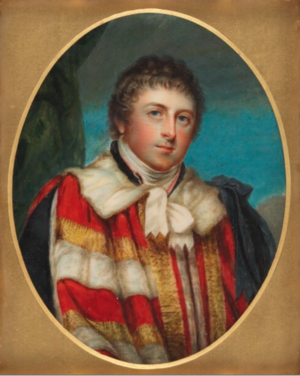
Aneponymous hairstyleis a particularhairstylethat has become fashionable during a certain period of time through its association with a prominent individual.
Women[edit]
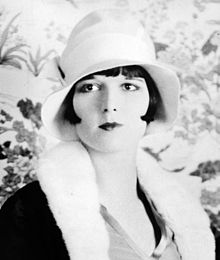
1920–1950[edit]
In the early 20th century, the "Louise Brooksbob"(Paramount studios' descriptionc. 1927of the defining "bob cut"of the"flapper"era) was iconic to the extent of being reproduced byCyd Charissein the filmSingin' in the Rain(1952), byMelanie GriffithinSomething Wild(1986), and byRose McGowaninThe Doom Generation(1995). Although photographs show that Brooks had in fact worn what became known as a bob from childhood, the actressColleen Moorec. 1923was probably the first to be widely associated with it. However, there was never such a thing as a "Colleen" and it was Brooks, with her unmistakable sense of "It",that turned the" Louise "into an eponymous classic.[1]Eighty years later, the term was still part of fashion's lexicon: "With her trademark Louise Brooks bob...Jean Muirbuilt a career as one of Britain's greatest designers. "[2]
1950s–1960s[edit]
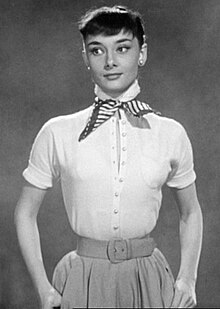
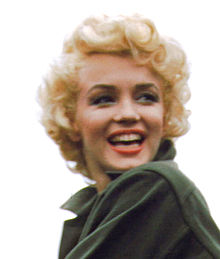
The "Audrey Hepburnlook”, associated since the 1950s with the Anglo-Belgian film actress, owed itself principally to the intrinsicchicof Hepburn herself (a factor identified byEdith Head[3]) and the designs of French couturierHubert de Givenchy.However, although never strictly eponymous, Hepburn's hairstyles - especially those in the filmsSabrina(1954) (short with a fringe, or "bangs", across the forehead) andBreakfast at Tiffany's(1961) (pulled back and gently piled up around the crown) have been widely copied. The social historianDominic Sandbrookwrote of "black-jersiedgamineswith Audrey Hepburn hairdos "presiding over British coffee bars in the mid-1950s.[4]
Marilyn Monroe's signature platinum blonde look, worn throughout the height of her career, was calledThe Marilyn.[5]In the 1960s, the pixie cut worn by the British modelLesley Lawsonwas calledThe Twiggyafter her nickname.[6]
Other short "gamine" cuts to have attracted imitators includedJane Fonda's as the call-girl Bree Daniels in the filmKlute(1971), and that adopted in 2005 by the actressKeira Knightley,[7]a longer, slightly shaggier version of Hepburn's cut. Fonda's style, which was also captured in photographs following her arrest for allegedly assaulting a police officer atClevelandairport in 1970, was sometimes - even 30 years later - referred to as the "Klute shag".
1970s–1990s[edit]

A famous example of this phenomenon wasFarrah Fawcett's hairstyle,[8]as seen in the American television seriesCharlie's Angelsin the 1970s. Another around that time was the short "Purdey"cut adopted by British actressJoanna Lumleyfor her role of that name in the television seriesThe New Avengers,and the shortDorothy HamillWedgehairstyle.
Other period examples such as "Bo Derek"(braided hair with beads, as she wore in the film10(1979)); and the "Rachel"(after thestraightenedshagpopularized in the mid-1990s byRachel Green,the character played byJennifer Anistonin the TV sitcomFriends);[8].
"Wannabe" effect[edit]
Imitation of such styles can sometimes be attributed to what became known in the 1980s as the "wannabe"effect, a term used particularly with reference to young women who wished to emulate (i.e."wanna be" like) the American singerMadonna.A 2010 study of British women found that half took a copy of a celebrity's photograph to their salons to obtain a similar hairstyle.[9]
The quest for a particular eponymous style was caricatured inPlum Sykes' novelBergdorf Blondes(2004), in which it was rumored that glamorous New York heiress Julie Bergdorf had her blonde hair touched up every 13 days ( "$450 a highlight" ) by a stylist at her family's store,Bergdorf Goodman.Thus, other "Thirteen Day Blondes" who attained Julie's precise colour—likened to that of the "very white" hair ofCarolyn Bessette-Kennedy—became known as "Bergdorf Blondes".
2000 to present[edit]
Recent examples of eponymous hairstyles include thePob(Posh + Bob) named afterVictoria "Posh" Beckham(called in 2007 the most wanted hair since the "Rachel" ); and the "Dido flip",a" choppy shag "associated with the singerDidoin the early years of the 21st century.
In 2006,The Timesnoted the transformation over several years in the hairstyle ofYulia Tymoshenko,a formerPrime Minister of Ukraine.Illustrated instructions for replicating Tymoshenko's distinctive blonde braided crown were headed "How to do theYuliya".[10]
In 2009, the most requested hairstyle for women was the "Textured and Tousled, or Curled and Swirled" long, blonde "Gossip GirlLook "done by actressBlake Lively.[8]
Men[edit]


Before 1800[edit]
In Europe, theRoman legionspopularized short hairfor free citizens, especially the close-croppedCaesar cutassociated to this day with statues ofTiberius Julius Caesar.
The 9th-century Islamic trend-setterZiryabis said to have popularized a shorter male hairstyle inCordoba,with bangs down to the eyebrows and straight across the forehead, and leaving the neck and ears uncovered.[11]
Before and during theEnglish Civil War,theVan Dyke beardwas worn by manycavaliersin imitation ofCharles I of England.The Dutch artistAnthony van Dycksported the same beard, as did the subjects of some of his paintings. The name for the beard style came much later.
In the transition from wigs to natural hair, the cut "à la Titus"was important. This was a layered cut usually with some tresses hanging down, named after the RomanTitus Junius Brutus,a character inVoltaire's playBrutus,when the actorFrançois-Joseph Talmashocked audiences by performing (in fact initially another character) with short hair and wearing a toga. The style was adopted by both men and adventurous women likeLady Caroline Lamb,theJournal de Parisreporting in 1802 that "more than half of elegant women were wearing their hair or wigà la Titus".[12]
Regency era[edit]
An early example of an eponymous hairstyle was associated with the5th Duke of Bedford.In 1795, when the British government levied atax on hair powder,as a form of protest Bedford abandoned the powdered and tied hairstyle commonly worn by men of that era in favor of a cropped, unpowdered style, making a bet with friends to do likewise.[13]The new style became known as theBedford Level,a pun on a geographical feature ofThe Fensalso known as the "Bedford Level" and also making reference to Bedford's radical ( "leveller") political views.[14]It was also known as theBedford Crop.[15]Although natural, the Bedford crop was usually styled with wax to form a side parting.
Victorian and Edwardian periods[edit]
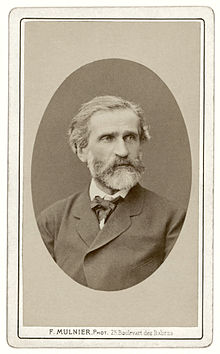
During the mid 19th century,facial hairbecame fashionable among soldiers and civilians.[16]Examples included the largemuttonchop sideburnspopularised byAmbrose Burnside,and variants of thefull beardnamed afterVerdiandGaribaldi.[17]TheBeard imperialorNapoleon,which combined ahandlebar moustachewith asoul patch,was named after EmperorNapoleon III of France,and thechinstrap beardwas informally known as theAbraham Lincoln.[18]
20th century[edit]
TheFu Manchu moustache,first worn byMandarinsinImperial China,gained its name from the fictionalsupervillainFu Manchu,a personification of theturn of the centuryyellow perilstereotype.
Since 1945, thetoothbrush moustachehas been nicknamedthe ChaplinandThe Hitler.[19]
During the 1950s,pompadourhairstyles were popularized by rock and roll singerElvis Presley,mostly among the youth and thegreasersubculture.
Thecover bandThe Crewcutswere the first to connect hair with pop music, but they were named after the hairstyle, rather than the reverse. Although eponymous styles are mostly associated with women, the "mop-top"Beatle cutof the 1960s (after therock group of that name) was one famous and widely copied example of such a style for men.
In the early 1970s the singerDavid Bowiepopularized the so-called"Ziggy cut",an orange-red form of "mullet"associated with the rather androgynous image that he promoted through his albumsThe Rise and Fall of Ziggy Stardust and the Spiders from Mars(1972) andAladdin Sane(1973). To the extent that Bowie during this period appeared to assume the persona of "Ziggy Stardust", the Ziggy cut can be regarded, at least partially, as an eponymous style.
Theshaved head,which had become a rarity by the mid 70s, was widely known as theKojakorYul Brynnerstyle.
Modern era[edit]
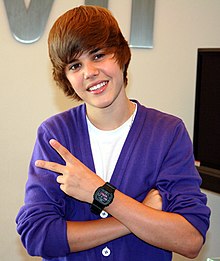
In the late 1990s, with the success of "ER",George Clooneypopularized theCaesar-style haircut worn by his character, Dr.Doug Ross.The style worked equally well for both young and older men alike, and Clooney's distinguishedsalt and peppercolor became very popular.
In more recent times the hair of footballersKevin Keegan,who acquired a curly "bubbleperm"while playing for Southampton in the early 1980s, andDavid Beckhamgave rise to much copying, but a"Beckham"was whatever style ( "buzz-cut", cornrows,Fauxhawk,even anAlice band) he happened to wear at a given time.[20]
A more specific eponymous example was the so-called "Sawyer"ofJames "Sawyer" Ford,the character played byJosh Hollowayin the ABC-TV seriesLost(2004–2010), or the shaggy "Justin Bieber haircut"debuted by thepop singerin 2009. Some salons charged up to $150 for the forward-combed look. When Bieber changed his hairstyle in 2011, it received considerable press. He gave the cut hair to talk-show hostEllen DeGeneres,who auctioned Bieber's hair on eBay, earning more than $40,000 for an animal charity.[21]
See also[edit]
Notes[edit]
- ^See Barry Parris (1991)Louise Brooks
- ^Sunday Times,4 June 2006
- ^See Ian Woodward (1984)Audrey Hepburn
- ^Sandbrook (2005)Never Had It So Good
- ^Rebecca Cox (10 February 2014)."The 100 most iconic hairstyles. Ever. (25)".Glamour Magazine.Archived fromthe originalon 2 April 2015.Retrieved20 March2015.
- ^Rebecca Cox (10 February 2014)."The 100 most iconic hairstyles. Ever. (95)".Glamour Magazine.Archived fromthe originalon 2 April 2015.Retrieved20 March2015.
- ^See, for example,She,July 2005
- ^abcNir, Sarah Maslin (2009-11-10)."A 'Gossip Girl' Look, Pronto!".The New York Times.Retrieved2010-07-06.
- ^Roche, Elisa (2010-05-26)."JENNIFER ANISTON'S A CUT ABOVE FOR 11 MILLION WOMEN".Daily Express.Retrieved2011-01-19.
- ^Times,20 May 2006
- ^Salma Khadra Jayyusi and Manuela Marin (1994),The Legacy of Muslim Spain,p. 117, Brill Publishers,ISBN90-04-09599-3
- ^Rifelj, Carol De Dobay,Coiffures: Hair in Nineteenth-Century French Literature and Culture,p. 35, 2010, University of Delaware Press,ISBN0874130999,9780874130997,google books
- ^An End of Hair Powder,London Chronicle, Sept. 26, 1795,Reprinted in the New York Times
- ^John Barrell,The spirit of despotism
- ^Hardinge, George (1818).Miscellaneous Works, in Prose and Verse, of George Hardinge.J. Nichols, Son, and Bentley. pp. Vol. 2, p. 396.
bedford crop.
- ^The long and the short
- ^Garibaldi beard
- ^Beard styles
- ^Jumpman's toothbrush moustache
- ^SeeSusie Dent(2003)The Language Report
- ^Tracy Nelson Maurer (2012).Justin Bieber.Capstone Press. p. 7.ISBN9781620653517.
External links[edit]
- The Ziggy Stardust haircut
- "History: 25 Hairstyles of the Last 100 Years"– 5: The Rachel, 1990s. Retrieved 2011, August 23 atListverse.
